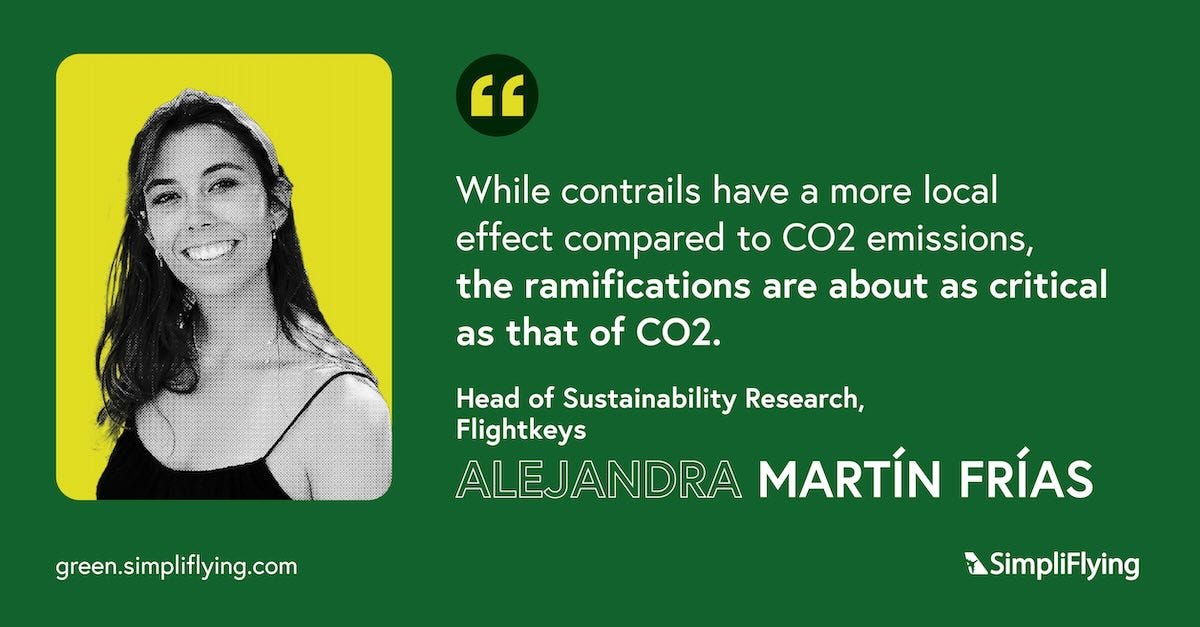In this episode of our ‘Sustainability in the Air’ podcast, Alejandra Martín Frías, Head of Sustainability Research at FLIGHTKEYS, speaks with SimpliFlying’s CEO Shashank Nigam and shares insights into the company’s research on contrail avoidance and its potential impact on aviation sustainability.
Founded in 2015, FLIGHTKEYS develops innovative flight planning and optimisation software to revolutionise flight management for the 21st century. The company works with airlines worldwide, including carriers like American Airlines, Southwest, Air New Zealand, Volotea and TUI, helping them balance cost efficiency, environmental impact, and safety.
Here are the key highlights of the conversation:
FLIGHTKEYS’ contrail avoidance study (4:10)
Understanding contrails and their impact (16:20)
Challenges in implementing contrail avoidance (20:10)
The EU’s MRV Program (28:20)
Global vs. regional considerations in contrail avoidance (34:15)
Integrating contrail avoidance into flight plan technology (47:40)
Rapid Fire! (51:20)
Keep reading for a quick overview of the episode.
Why contrail avoidance matters
Condensation trails, also known as contrails, are long, thin clouds that often form behind an aircraft in cold and humid conditions when water vapour freezes around small dust and soot particles from the engine. Although they look harmless, contrails are made up of small ice crystals that can trap heat in the Earth’s atmosphere and contribute to global warming.
Recently, FLIGHTKEYS was part of a study that simulated contrail avoidance for about 85,000 flights. The study, published in February 2024, analysed two weeks of American Airlines flights in June, and two weeks in January. Flight data was sourced directly from American Airlines for the analysis, which allowed for a realistic simulation of flight performance.
The study explored three scenarios:
Rerouting every flight that generates a warming contrail – about 11,000 out of 85,000 flights.
Rerouting the “big hits” – based on the concept developed by Mark Settler and Roger Teo from Imperial College, suggesting that approximately 2% of all flights that generate contrails are responsible for 80% of warming.
Cost-based rerouting – identifying the most cost-efficient reroutings for the biggest impact.
Frías shares that the study demonstrated significant reductions in contrail energy forcing with minimal increases in fuel consumption and overall costs.
For the first scenario, rerouting 11,000 flights resulted in a 73% reduction in energy forcing with only a 0.11% increase in fuel consumption and a 0.08% increase in cost.
The “big hits” scenario showed a 66% decrease in contrail energy forcing by rerouting just 2,200 flights, with a 0.05% increase in fuel and a 0.03% increase in cost.
The cost-based scenario produced similar results to the “big hits” approach, needing to reroute 2,400 flights.
4 takeaways from the conversation
1. Understanding contrails and their impact
Depending on the time of day and atmospheric conditions, contrails can have either a warming or a cooling effect on the Earth’s climate.
Frías explains that contrails formed during the night are generally warming, as they trap heat. During the day, contrails can have either a cooling or warming effect, or a combination of both, based on how long they persist in the atmosphere. A contrail produced in the late afternoon might begin as cooling but transition to warming as night falls. The impact also depends on factors like the Earth’s albedo and the presence of other clouds.
Frías argues that the impact of non-CO2 emissions is at least as important as CO2 emissions, in terms of the energy balance. While CO2 has a global, long-term effect, contrails are more localised but can potentially have a more significant short-term impact. Contrails are especially impactful in regions with high air traffic like Europe and the US, she adds.
2. Challenges in implementing contrail avoidance
While contrail avoidance can lead to a significant reduction of aviation’s warming impact, implementing it is not as straightforward, says Frías. She identifies three underlying challenges:
Operational complexities: Implementing contrail avoidance in real-world scenarios requires managing several variables:
The unpredictability of weather conditions that make long-term planning difficult;
The need for coordination between flight dispatchers and pilots;
The requirement for extensive training of airline staff;
And the complexity of integrating contrail avoidance with existing flight optimisation practices.
Frías shares that airlines often plan which flights will perform contrail avoidance days or weeks in advance, but weather conditions can change rapidly, potentially rendering these plans ineffective.
Cost considerations: Frías explains that flight optimisation is not solely about minimising fuel consumption but involves a complex cost formulation, including engine cycle costs, fuel costs, and overflight charges (such as costs for crossing specific airspaces). These factors can influence flight routes, as airlines would want to avoid higher charges. This can be an important consideration, especially for reroutings.
Industry inertia and uncertainty: The airline industry, at the moment, is a bit reluctant to conduct contrail trials, notes Frías. The inertia stems from several factors:
Uncertainty in weather predictions and contrail formation;
Difficulty in verifying successful contrail avoidance;
And the fear of potential future taxation on non-CO2 emissions.
“The thing about contrails and in general weather reroutings, is that it’s very unpredictable. You can’t plan something many months in advance or weeks in advance when it’s weather dependent.”
3. Policy and regulation
Last year, the European Union announced a landmark decision that will require mandatory monitoring, reporting and verification (MRV) of non-CO2 emissions from all flights departing, arriving, as well as within the European Economic Area from January 2025.
The industry, however, is quite divided over the new MRV rules. There’s an ongoing debate between voluntary approaches and mandatory regulations, as well as the potential for incentives or penalties related to contrail formation.
Frías notes that there has been lobbying against the MRV program, particularly from the IATA and some airlines who argue that the science behind non-CO2 emissions is too uncertain. However, according to Frías, improving the science around contrails, reducing uncertainty, and collecting data through programs like MRV are necessary steps before implementing any potential regulations or incentives.
“If we don’t perform flight trials and monitor flights, we will never improve the uncertainties surrounding contrail modelling.”
4. Technological integration
FLIGHTKEYS has implemented contrail avoidance functionality in both their flight dispatching tool and their Electronic Flight Bag (EFB) tool for pilots.
The flight dispatching tool is used by dispatchers 3-12 hours before departure to plan and file routes, which are then approved by authorities and sent to the cockpit. The EFB tool is used by pilots during the flight. FLIGHTKEYS aims to use these tools together for contrail avoidance. Frías explains that the approach mirrors current practices for avoiding turbulence, where both dispatchers and pilots play a role in route optimisation.
FLIGHTKEYS is also working towards continuously updating and improving their contrail detection models through collaborations with Breakthrough Energy and Google Research.
“We’re like the bridge between these brilliant academic people who develop all of [these contrail models and research] and who try to improve the models and also the way of verifying it afterwards, and the operators.”
‘Sustainability in the Air’ is the world’s leading podcast dedicated to sustainable aviation. Through in-depth conversations with top aviation leaders, we break through the clutter and provide a clear roadmap for a net-zero future.













